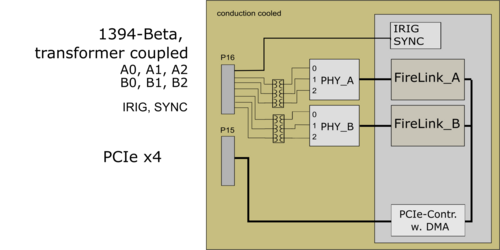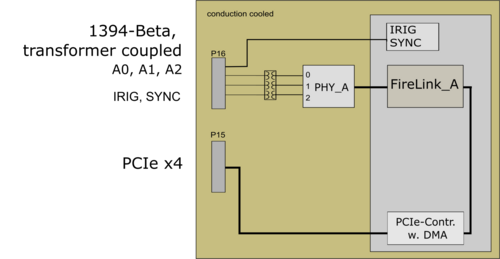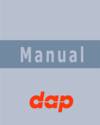- Home
- Products
- Summary & Overview
- Bus Analyzer
- Interface Cards
- FireRepeater
- Connectivity
- IP Cores
- Software
- Accessories
- Solutions
- Support
- News
- Contact
- Company
- Mil1394
- Sitemap
- Search

The FireTrac446bT-CC and FireTrac2446bT-CC feature the FireTrac® family functionality in the widely used XMC mezzanine card form factor with conduction cooling. The cards are compliant with the VITA20-2005 (S2018) and are designed to work in VPX (VITA46) and VME (VITA41.4) platforms.
They use the latest versions off-the-shelf PHY layer silicon (TSB41BA3/TSB81BA3) together with Dap's FireLink® Extended IP Core.
The HW also provides IRIG time-stamping of monitored events and accepts IRIG-B122 (TTL) inputs.
Both cards are also avaiable in versions supporting S100 as well as S800.


For this version of FireTrac® DapTechnology uses the designated differential pins on the XMC-connector (P16) for the offboard connectivity of the 1394 buses (A0-A2, B0-B2) together with the IRIG & Sync inputs.
The exact P16 connector signal and pin assignment is provided in the product datasheet.
| Dimensions: | 74 x 143.75mm, in compliance with VITA20-2005 (S2018) | |||
| Weight: | ~ 80 g | |||
| Power Requirements: | +3.3V, VPWR (+5V or +12V) 7 Watts (max.) |
|||
| Regulatory Compliance: | FCC Class A, CE | |||
| Connections: | P15, P16: compliant with VITA 42.0 | |||
| Indicators: | 4x LED Config, PCI width, PCI speed, Debug |
|||
| Switches: | - | |||
| Part Number: |
FT446bT-CC-OPT1-OPT2-OPT3 or FT2446bT-CC-OPT1-OPT2-OPT3 |
|||
| Options: |
OPT1: Operating System |
OPT2: Personality Profile
FFP – Full Personality Profile |
OPT3: Extended Warranty |
|
| Codes: |
Export Control: EAR99 HTS: 8471.80.10.00 |
|||


In order to get the best out of the unique feature set of the FireTrac card DapTechnology recommends using the hardware in combination with FireStack, i.e. DapTechnology's home grown software stack.
FireStack optimally supports the hardware and firmware layers embedded into FireTrac. As FireTrac's host interface uses FireLink Extended (and not a standard OHCI Link Layer chip) functionality that has been tailored and optimized for the support of the AS5643 standard brings the combination of FireTrac and FireStack to an entirely new level.
The objective of FireStack’s® 1394 packet handler is to reduce resource burden when receiving and transmitting 1394 packets. The consistent utilization of zero-copy operations greatly enhances the overall system performance. FireStack® provides memory buffers accessible by both the user application and the 1394 Link Layer DMA engine.
For example, when transmitting an asynchronous packet and the user application has filled the memory buffer with the needed packet data, FireStack® will hand the buffer directly to the Link Layer for reading the packet into the packet transmission FIFO without having the CPU copy memory to memory.
Likewise, displaying a video stream from an IIDC camera only requires creation of DMA-capable reception buffers for the video frame data and registration of notification upon filling of a complete frame. Once notified the buffers holding the received data can be accessed directly by the video rendering engine in order to move the data to video card memory.
Inbound Transactions (handling of incoming requests) are defined in two separate methods:
Map Local Memory: The user can "map" a memory buffer to a specific address space. The contents of the memory buffer can be accessed by the user application at any point in time. At the same time when the stack receives a request packet from a remote device it will automatically perform the response operation (read, write or lock) and will send a response packet back to the requester. The user has the option to be notified by the notification callback function when the transaction completes.
Transaction Handler: Similar to the Map Local Memory above the user can "register for" a specific address space instead of "mapping" local memory. When the stack receives a request packet it will call the user-specified handler callback function. The user can then perform any operation within the callback function. Upon returning from the handler callback, the FireStack® may transmit a response packet. The notification callback function will be called after completion of the response process.
This module can be used to perform memory transactions (read, write, lock) on remote nodes. When a memory transaction is initiated FireStack® will automatically determine the maximum speed to the destination node by performing the needed PHY remote accesses.
Outbound Transactions can be used in the following ways with respect to result indication: In Blocking mode the TX functions will not return until the response packet is received and thus making the code sequential. In contrast to that the Non-Blocking mode can be used to initiate a series of “split” transactions i.e. a series of requests that are then followed by the corresponding - but not necessarily sequential - responses.
The Isochronous Streaming modules build on the mechanisms for efficient data processing defined by OHCI and provide a flexible and user-friendly API around it. Linked lists of buffers can be setup by the user application and will be automatically processed by the Link Layer DMA engine. Notification mechanisms are available for buffer and/or packet completion.
An essential feature of FireTrac® is its thin software and firmware layer. In order to be usable in embedded designs having limited resources, great emphasis was given to keep the footprint and host system resource utilization as small as possible. And, in order to optimize and streamline performance, the individual features and functions of FireTrac® are grouped into so-called Personality Profiles. These profiles may be purchased separately so that the user may configure their system based on individual requirements.
The Personality Profiles allow the solution to be adapted for use in embedded systems which typically have limited resources, and/or with powerful host processors that can utilize even the fully featured profile.
The following profiles are available:
The SAE-AS5643 protocol differs from other 1394 protocols because of its stringent timing requirements. Because of potential inaccuracies and unpredictable latencies possible with software implementations, DapTechnology strongly believes that the AS5643 protocol timing is best implemented via a HW extension in the 1394b Link Layer. Therefore, DapTechnology has added the AS5643 protocol timing into FireLink® Extended as an integral module. With this HW support FireLink® Extended is easily capable of meeting the AS5643 frame timing requirements and eliminates the need for complicated interrupt schemes or real-time operating systems typically needed to efficiently use the AS5643 protocol.
The FireStack® software library contains an AS5643 protocol module that can be used to control the AS5643 hardware of FireLink Extended enabled products (e.g. the FireTrac I/O card). Optimized frame timing can be configured and used for both timed transmission and reception.
Frame Timing: FireStack® is very flexible in the way it handles the timing of Start of Frames. Frame synchronization for AS5643 reception and transmission may be configured as either:
In addition to acting as a synchronization “slave”, it is also possible for each bus to act as STOF master and output a sync pulse on an External Sync Pin.
Reception: AS5643 reception provides a filtering mechanism and all incoming packets will be run against a comprehensive verification system. Messages can be filtered on channel number, AS5643 message ID or a combination of both.
Transmission: AS5643 Transmission module can be used to control devices that support AS5643 timed transmission in. FireTrac® offers very accurate transmission timing. The following transmission modes are available:
Streaming messages: Allows writing large or small sets of messages to FireStack® and having them transmitted automatically at specified frame offset times. The provided data needs to contain so called frame separator elements to indicate that the following message needs to be transmitted in the next frame.
Repeating messages: Allows setting up a message that will automatically be transmitted each frame by FireTrac hardware. The user will have a pointer to the actual data of the message and is allowed to manipulate the data at any point in time without having to worry about its timed transmission. This is very useful for AS5643 status messages.
Single messages: Allows simply transmitting a message as soon as possible but exactly at the specified frame offset time. Several messages may be handed to the FireStack® for immediate transmission and the FireStack® will then take care of the actual moment of transmission.
STOF Messages: Allows controlling transmission of STOF messages.

Manual available on request
Please note that no cables or other accessories are applicable for this product.
Please note that no cables or other accessories are applicable for this product.
Typically 4 weeks. Please contact sales(at)daptechnology.com for more detailed information.
Standard: 48 months, limited.
Options: Additional 1-year SW/FW Support packages may be purchased.
All products will be supported on a 24 hours response basis and free of charge during the warranty period. For support questions please contact: sales(at)daptechnology.com
Of course you can also call us during our office hours from 9:00 until 17:00 hours (GMT +1:00). Contact Info
For those educational institutions that would like to use our high-specification IEEE-1394 analyzer for educational purposes only, we have a special discount offer. Our FireSpy® software which runs automatically in demo-mode without the use of a FireSpy® has great educational properties. This software can be used for free by everyone and is of great value for learning IEEE-1394. In order to obtain more details about this offer, please contact: sales(at)daptechnology.com
Please contact sales(at)daptechnology.com for current pricing.
| Country | Distributor | Phone | URL |
|---|---|---|---|
| China | BEIJING CESITEK CO., LTD. | +86 10 84177715 | www.cesitek.com |
| Japan | Nacelle Co. Ltd. | +81-3-5921-5099 | www.nacelle.co.jp |
| United States of America | DapUSA, Inc | +1 480 422 1551 | www.dapusa.com |
| South Korea | Realtimewave Co. Ltd. | +82-31-698-2980/2 | www.realtimewave.com |
| all other countries | Dap Technology B.V. | +1-514-453-4111 | www.daptechnology.com |
Click here for a more detailed listing of our Sales Representations.
For the U.S.A., we have as representatives:
| Representative | Territory | Phone | URL |
|---|---|---|---|
| Dap USA Office Arizona | Entire United States of America | +1 480 422 1551 | www.dapusa.com |
To place an order for DapTechnology products, please print one of the following order forms and email it to the corresponding email address:
USA:
Dap USA, Inc.
sales(at)dapusa.com
Download order form
Or contact us by phone: +1 480 422 1551
Rest of the world:
Dap Technology B.V.
sales(at)daptechnology.com
Download order form
Or contact us by phone: +1 480 422 1551